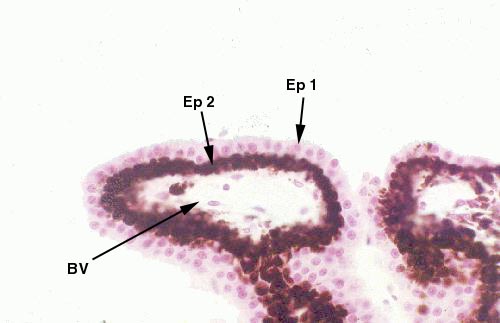Ciliary Epithelium
 The ciliary epithelium has a pigmented and an unpigmented
portion. It's really a bilayered covering of the ciliary processes. The pigmented cells
(Ep2) rest on a basal lamina and are close to an underlying blood vessel (BV).
The unpigmented cells (Ep2) are exposed to the posterior chamber.
The ciliary epithelium has a pigmented and an unpigmented
portion. It's really a bilayered covering of the ciliary processes. The pigmented cells
(Ep2) rest on a basal lamina and are close to an underlying blood vessel (BV).
The unpigmented cells (Ep2) are exposed to the posterior chamber.
The two layers are continuous with the retinal pigment epithelium and derived from the optic cup. Aqueous humor produced by the ciliary body has a composition with exactly the right refractive index, and other properties which
serve the needs of the internal structures. The aqueous
humor is also the route for nutrient transport to the avascular lens. Its production has to take into account the special requirements of the fragile and physiologically delicate internal structures.
The eye, like the brain, has to have a barrier between it and the
rest of the real world, to prevent passage of deleterious materials
from the blood directly into the aqueous humor. The composition
of aqueous humor with respect to electrolytes and so forth is
very different from that of the blood. In order to maintain this
difference, free passage of ions and so forth can't be allowed. These
two layers of cells are part of that barrier: they're sealed
together by occluding junctions, so that blood-borne material has to
go through both layers of cells before reaching the posterior
chamber. In other words, the occluding junctions between these two layers physically seal off the eye and give these
cells total control over what does and doesn't get in.
Monkey eye; H&E stain, paraffin section, 400x

Close This Window
 The ciliary epithelium has a pigmented and an unpigmented
portion. It's really a bilayered covering of the ciliary processes. The pigmented cells
(Ep2) rest on a basal lamina and are close to an underlying blood vessel (BV).
The unpigmented cells (Ep2) are exposed to the posterior chamber.
The ciliary epithelium has a pigmented and an unpigmented
portion. It's really a bilayered covering of the ciliary processes. The pigmented cells
(Ep2) rest on a basal lamina and are close to an underlying blood vessel (BV).
The unpigmented cells (Ep2) are exposed to the posterior chamber.
